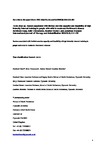Factors associated with limited exercise capacity and feasibility of high intensity interval training in people with mild to moderate Parkinson's disease
| dc.contributor.author | Haas, Bernhard | |
| dc.contributor.author | Cinnamond, S | |
| dc.contributor.author | Hunter, Heather | |
| dc.contributor.author | Marsden, Jonathan | |
| dc.date.accessioned | 2016-09-28T15:54:36Z | |
| dc.date.available | 2016-09-28T15:54:36Z | |
| dc.date.issued | 2016-09-09 | |
| dc.identifier.issn | 1741-1645 | |
| dc.identifier.issn | 1759-779X | |
| dc.identifier.uri | http://hdl.handle.net/10026.1/5494 | |
| dc.description.abstract |
<jats:sec><jats:title>Background/Aims:</jats:title><jats:p> Fitness and function can improve with exercise in people with Parkinson's disease. Animal models suggest that exercise may also have a neuroprotective effect, with higher intensity exercise being more beneficial than lower intensity exercise. However, in people with Parkinson's disease the factors limiting exercise capacity are not fully understood and it is unclear whether training at very high intensities would be safe, feasible and acceptable. </jats:p></jats:sec><jats:sec><jats:title>Methods:</jats:title><jats:p> Eighteen people with Parkinson's disease were recruited to explore respiratory and neuromuscular factors that may limit exercise capacity. In a purposive subgroup of 6 participants able to achieve >75% of their predicted maximum heart rate the feasibility of undertaking six high intensity interval training sessions over 3 weeks was tested. Their experience was further explored in a focus group. </jats:p></jats:sec><jats:sec><jats:title>Results:</jats:title><jats:p> Lower exercise capacity was associated with lower limb flexor muscle strength (r<jats:sup>2</jats:sup>=0.51) but not with disease severity or respiratory function. There were no adverse events or drop-outs in those taking part in the exercise regimen. Improvements were seen in fitness, health related quality of life, activity levels, walking speed, muscle strength and cycle endurance. Participants reported that they enjoyed high intensity, supervised exercise. High intensity interval training may be feasible and safe. </jats:p></jats:sec><jats:sec><jats:title>Conclusions:</jats:title><jats:p> We concluded that high intensity interval training has the potential to be a safe and acceptable mode of exercise in this patient group. </jats:p></jats:sec> | |
| dc.format.extent | 414-422 | |
| dc.language | en | |
| dc.language.iso | en | |
| dc.publisher | Mark Allen Group | |
| dc.subject | Parkinson's Disease | |
| dc.subject | Aging | |
| dc.subject | Brain Disorders | |
| dc.subject | Cardiovascular | |
| dc.subject | Clinical Research | |
| dc.subject | Neurosciences | |
| dc.subject | Prevention | |
| dc.subject | Neurodegenerative | |
| dc.subject | 6.7 Physical | |
| dc.subject | Neurological | |
| dc.title | Factors associated with limited exercise capacity and feasibility of high intensity interval training in people with mild to moderate Parkinson's disease | |
| dc.type | journal-article | |
| dc.type | Journal Article | |
| plymouth.issue | 9 | |
| plymouth.volume | 23 | |
| plymouth.publication-status | Published | |
| plymouth.journal | International Journal of Therapy and Rehabilitation | |
| dc.identifier.doi | 10.12968/ijtr.2016.23.9.414 | |
| plymouth.organisational-group | /Plymouth | |
| plymouth.organisational-group | /Plymouth/Faculty of Health | |
| plymouth.organisational-group | /Plymouth/Faculty of Health/School of Health Professions | |
| plymouth.organisational-group | /Plymouth/REF 2021 Researchers by UoA | |
| plymouth.organisational-group | /Plymouth/REF 2021 Researchers by UoA/UoA03 Allied Health Professions, Dentistry, Nursing and Pharmacy | |
| plymouth.organisational-group | /Plymouth/Research Groups | |
| plymouth.organisational-group | /Plymouth/Research Groups/FoH - Applied Parkinson's Research | |
| plymouth.organisational-group | /Plymouth/Research Groups/Institute of Health and Community | |
| plymouth.organisational-group | /Plymouth/Users by role | |
| plymouth.organisational-group | /Plymouth/Users by role/Academics | |
| dcterms.dateAccepted | 2016-02-29 | |
| dc.identifier.eissn | 1759-779X | |
| dc.rights.embargoperiod | Not known | |
| rioxxterms.versionofrecord | 10.12968/ijtr.2016.23.9.414 | |
| rioxxterms.licenseref.uri | http://www.rioxx.net/licenses/all-rights-reserved | |
| rioxxterms.licenseref.startdate | 2016-09-09 | |
| rioxxterms.type | Journal Article/Review |


